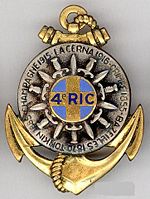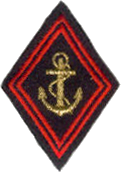Loading AI tools
Military unit From Wikipedia, the free encyclopedia
The 4th Marine Infantry Regiment (French: 4e Régiment d'Infanterie de Marine, 4e RIMa) was a French marine regiment of the troupes de marine within the French Army. This regiment was part of the « Quatre Grands » of the Marine Infantry along with the 1st Marine Infantry Regiment 1er RIMa, the 2nd Marine Infantry Regiment 2e RIMa, the 3rd Marine Infantry Regiment 3e RIMa, however was dissolved in 1998. Along with the 1st Marine Artillery Regiment 1er RAMa and 2nd Marine Artillery Regiment 2e RAMa, the 4th Marine formed of the two brigades of the Blue Division. On June 14, 2001, the GSMA of Mayotte, heir to the 4th Marine Infantry Regiment, received the color guard of the regimental colors.
This article includes a list of references, related reading, or external links, but its sources remain unclear because it lacks inline citations. (February 2013) |
You can help expand this article with text translated from the corresponding article in French. (December 2008) Click [show] for important translation instructions.
|
| 4th Marine Infantry Regiment | |
|---|---|
| 4e Régiment d'Infanterie Marine | |
  Regimental insignia of the 4e RIC Regimental insignia of the 4e RIMa | |
| Active | August 31, 1854, to June 30, 1998 |
| Country | France |
| Branch | French Army |
| Type | troupes de marine |
| Role | Infantry |
| Garrison/HQ | Toulon et Fréjus |
| Motto(s) | « J'y suis j'y reste »(Fr) Here I be, here I stay (Eng) |
| Colors | Red and blue |
| Anniversaries | Bazeilles |
| Engagements | Crimean War Second Franco-Traza War Cochinchina Campaign Tonkin Campaign Franco-Prussian War World War I World War II Algerian War |
| Battle honours |
|

This section is empty. You can help by adding to it. (June 2016) |
This section is empty. You can help by adding to it. (June 2016) |
The 4th Marine Infantry Regiment illustrated capability first in Crimea (1854–1855) participating to the Siege of Sebastopol. Following this campaign, the Emperor decided that the regimental colors of the 4th Marine Infantry Regiment would bear the golden inscriptions letters of « Sébastopol ». In 1859, the Regiment took part in the Second Italian War of Independence against the Austrian Empire.
Starting in 1855, and for the next fifteen years, 4 out of the Regiment's 34 companies were stationed in Senegal. Under the leadership of the French governor Louis Faidherbe, they took part in various wars against local Kingdoms and Empires. From 1855 to 1858, the companies were involved in the Second Franco-Traza War, notably at the Battle of Dioubouldou and the Battle of Leybar Bridge. From 1855 to 1860, they had various encounters with the forces of Oumar Tall's Toucouleur Jihad in the Futa Tooro, the most notable one being the Siege of Fort Médine. Between 1861 and 1870 they took part in the conquest of Cayor against the Damel Lat Jor, notably at the Battle of Loro in 1864 and the Battle of Louga in 1869. In April 1870, the 4th was replaced in Senegal by the 1st Marine Infantry Regiment.
The Regiment was involved in China, during the Second Opium War and the Taiping Rebellion. Following, the regiment was called to battle in the Cochinchina Campaign and then in the Tonkin Campaign which valued the regiment with new inscriptions on the regimental colors :
Saigon (1859)-Ki Hoa (1861)-Langson (1884)-Tuyen Quan (1885). Sébastopol 1854–1855 - Saïgon 1859 - Ki Hoa 1861 - Langson 1884 - Tuyen Quan 1885, battles also inscribed on the regimental colors of the 22nd Colonial Infantry Regiment, 22e RIC.
On August 17, 1870, the 4th Marching Marine Infantry Regiment was part of the Armée de Châlons (1870) (French: Armée de Châlons (1870)) of Marshal de MacMahon.
- August 23 to 26 1870 - March towards the east.
- August 31, 1870 - Battle of Bazeilles.
Attachments:
French Army of the Orient, AFO:
The installation have known their full developments after the war. The garrison of Fréjus became a center of formation and perfection as well as a transit center.
On May 1, 1923, the regiment was designated as 4th Colonial Tirailluers Regiment (French: 4e régiment de tirailleurs sénégalais) by change designation.
During the interwar period, the regiment participated to the campaign of the Levant in 1925.
The 4th Colonial Infantry Regiment 4e RIC recreated at Toulon for the campaign of October 15, 1939.
The 4e RIC with various elements was integrated in the 2nd Colonial Division, under the orders of général Maignan. The regiment was engaged on the Rhin then in Aisne at the beginning of the second world conflict. Dissolved on July 14, 1940.
On March 1, 1943, the « 4 » was reconstituted in Senegal at the corps of the 9th Colonial Infantry Division 9e DIC.
The regiment participated to the conquest of île Elbe, on June 17, 1944
Two months later, it was the disembarking in provence at Saint-Tropez, Saint-Raphaël and then Toulon. The regiment was of all combats of the Liberation until October 31, 1944.
With second world war, Fréjus maintained. The camps were brought back to their initial missions since 1945, taking the role of training and transit centers. Arbitrating the center of organization of the French far east expeditionary corps. Then the precolonial center of instruction, before rejoining Indochina, Madagascar and later North Africa.
After 1960, the garrison lost the African detachments, which the last left Puget in September 1964. The camps of south-east were composed of almost 12000 men, then four hospitals, cemeteries were created (annamite cemetery, African cemetery of Baume). Accordingly, the military domain was restrained, camps were left over (camp Galliéni, camp Robert, Camp Caïs). These lands in 2011 are today occupied by a sporting complex and by the Memorial of Indochinese Wars (French: Mémorial des guerres en Indochine).
At the cease-fire on March 19, 1962, in Algeria, the I/4e RIMa created among 91 other regiments, part of the 114 local forces. The I/4e RIMa was a local force of the Algerian order of battle, 420°UFL-UFO at Canrobert, composed of 10% metropolitan military and 90% of Muslim military, and which during the transition period were at the service of the executive provisional Algerian authority, until the independence of Algeria (Evian accords of March 18, 1962).
(* Initially referred to as camp de la Lègue, baptized following the Second World War after an officer killed fighting for France in Indochina on Mars 1945. Having served in Soudan and Mauritania, colonel Le Coq was referred as the Grand Méhariste and Compagnon de la Libération.)
This section is empty. You can help by adding to it. (June 2016) |
The anniversary is celebrated for combats in Bazeilles, the village which was apprehended and abandoned four consecutive times under orders, respectively on August 31 and September 1, 1870.
In the Name of God, vive la coloniale !
The Marsouins and the Bigors have for Saint, God. This war calling concludes intimate ceremonies which part life in the regiments. Often also at origin as an act of grace to Charles de Foucauld.
This section is empty. You can help by adding to it. (June 2016) |

The regimental colors of the 4th Marine Infantry Regiment 4e RIMa is decorated with:
|
|
|
|
Seamless Wikipedia browsing. On steroids.
Every time you click a link to Wikipedia, Wiktionary or Wikiquote in your browser's search results, it will show the modern Wikiwand interface.
Wikiwand extension is a five stars, simple, with minimum permission required to keep your browsing private, safe and transparent.